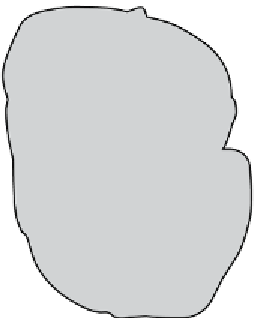Agriculture Reference
In-Depth Information
Caudate process
Coronary
ligament (cut)
Gall bladder
Caudal vena cava
Hepatic veins
Esophageal
impression
Falciform
ligament (cut)
Figure 2.6
Liver of ox, diaphragmatic surface, hardened in situ.
Liver
With the exception of the horse, the livers of all the
food animals are reddish brown in colour. The liver, the
largest gland in the body, lies mainly to the right of
the midline in all animals, its convex anterior surface
conforming to the hollow of the diaphragm to which it
is attached on its dorsal surface and its concave visceral
surface (with portal vein, hepatic lymph nodes, gall
bladder, common hepatic duct and hepatic artery) in
contact with the pancreas, reticulum, omasum and
abomasum with the caudal vena cava prominent on its
dorsal border.
Renal impression
Caudate process
Bile duct
Caudal vena
cava
Cystic duct
Portal vein
Gall bladder
Hepatic artery
Notch for
round ligament
Omasal
impression
Lesser
omentum
Reticular
impression
Abomasal
impression
Ox (Fig. 2.6)
The liver is poorly divided into three lobes: a thin left, a
thicker right, and a caudate lobe or thumb piece. The left
and right lobes are divided by a slight notch, the umbili-
cal fissure, which indicates the point of entry of the
umbilical vein while the calf is
in utero
. In the cow, the
left lobe of the liver is thin, elongated and often mark-
edly cirrhotic. Running transversely across the upper
border of the liver is the posterior vena cava, and on its
posterior aspect, the liver shows the root of the omen-
tum, gall bladder, portal vein and portal lymph nodes,
the vein and lymph nodes being partly concealed by
the pancreas.
The weight of the ox liver is about 5.4 kg, that is, about
1% of the live weight, although in feedlot cattle and
heavier animals, the liver may weigh up to 6.3 kg. The
calf liver, which is relatively larger than in the adult,
Figure 2.7
Liver of sheep, visceral surface, hardened in situ. The
papilliary process is the round projection between the omasal
impression and the left branch of the portal vein.
weighs 0.9-1.1 kg; its tenderness, its usual freedom from
parasitic and other pathological conditions and its ther-
apeutic value in the treatment of anaemia ensure the
highest price.
Sheep (Fig. 2.7)
The liver is similar in shape to that of the ox, but the
caudate lobe is more pointed and its edges are well
defined. This is a useful distinguishing feature between
the sheep and calf liver. The caudate lobe in the latter is
more rounded and has a blunter extremity which fre-
quently extends beyond the lower edge of the liver.


























































